Community
Gig Harbor Now and Then | A freight railroad for Gig Harbor
This is a heavily edited excerpt from “The Gig Harbor Railroad That Never Was,” by Greg Spadoni, Copyright © 2016.
Community Sponsor
Community stories are made possible in part by Peninsula Light Co, a proud sponsor of Gig Harbor Now.
The Puget Sound economy was booming in 1890 and enthusiasm for the future was about as high as it ever gets. That should’ve been a warning, as euphoria is often a prelude to disaster.
Businesses were started and building projects completed as fast as the financing could be arranged, with little more than a vague idea of their practicality. Some big thinkers saw Gig Harbor as the gateway to the natural riches of the Olympic Peninsula. In pursuit of those riches, in September 1890, Gig Harbor was the focus of a rail line envisioned by two different entities.
In Congress, a House bill passed committee to grant a 100-foot right-of-way to the Tacoma & Olympia Railway and Navigation Company on the military reservations on the east and west sides of Gig Harbor and Points Evans and Fosdick, subject to approval of the Secretary of War of a specific route across the land. Nothing ever came of it.
The other entity was the Union Pacific Railroad. It enlisted Frank C. Ross, a prominent Tacoma real estate speculator, businessman, and sometimes Gig Harbor resident (his parents, Marcellus and Martha, lived in the Harbor for years in a house he owned), to explore the idea of routing an Olympic Peninsula railroad through Gig Harbor.
Ross was fairly new to railroads, yet not entirely inexperienced, being a part owner and financier of the tiny Tacoma & Lake City Railroad. Built the previous year, it ran from North Tacoma to American Lake.
A survey expedition organized by Ross determined it to be not only feasible, but fairly straightforward to run trains from Gig Harbor to other points on the peninsula. Though the Union Pacific ultimately passed on the idea, Ross decided to build his own railroad along the route, the survey of which he had paid for himself.
Named the Tacoma & Northwestern Railway, Ross’ road was to run from Gig Harbor to Sidney (now known as Port Orchard), then to Port Gamble. Train cars would be ferried across Hood Canal to Port Ludlow, and continue on rails through the Chimacum Valley to Port Townsend, with some of the line paralleling the newly built Port Townsend Southern road.
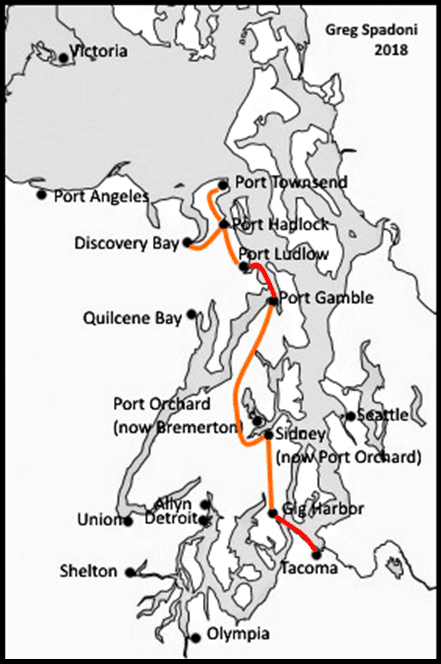
The first Frank Ross plan for a railroad through Gig Harbor terminated in Port Townsend.
The primary objective of the railway was to access existing lumber production from sawmills in Ports Gamble, Discovery, Ludlow and Hadlock. Spurs could reach any others that might be constructed on the east side of the Olympic Mountains in the future.
Train cars of lumber arriving in Gig Harbor would be ferried to Tacoma, where transcontinental railroads could take them anywhere in the country.
Other freight
After the forests in the lowlands had been cleared and turned into farms, agriculture products would also be shipped on the railroad. The new line would bring freight from Clallam, Jefferson, and Kitsap counties, currently routed mostly through Seattle (via steamboat), to Tacoma instead. Port Townsend goods could reach Tacoma by rail two hours sooner than Seattle by ship, apparently an important distinction at the time.
Ross claimed the line would be an easy run for locomotives, as the entire grade would not exceed 1%. He was offered 3,000 free acres for terminal facilities at Port Hadlock by Samuel Hadlock and other residents. He intended to bring in partners to help finance the line and expected the road to be built by 1893 or ’94, but it was not. He did not give up on the idea, however, and would return to it before the decade was out.
Frank Ross and his partners in the Tacoma & Lake City Railroad sold the line to the Union Pacific in 1891 at a great profit. But instead of pressing his plan for a railroad through Gig Harbor, he turned his attention to the construction of a railway from Tacoma to Seattle in 1892. The route was already being served by the Northern Pacific, with others soon to follow, but Ross was convinced he could compete successfully. Before it was completed, the project was stopped by a court ruling that determined he was in violation of the law by having secured rights of ways on Indian land from the Puyallup tribe.
The Northern Pacific Railroad was interested
Frank Ross was not alone in believing Gig Harbor was a prime location for a railroad crossing Puget Sound. In 1893, a civil engineer from the biggest railroad in the state, the Northern Pacific, surveyed a potential track line from Gig Harbor through Sidney and Bremerton to Beef Harbor on Hood Canal. From there, the railcars would cross by barge to tracks at Fish Harbor on the southern tip of the Toandos Peninsula and continue to Port Hadlock. The Northern Pacific never built the line.
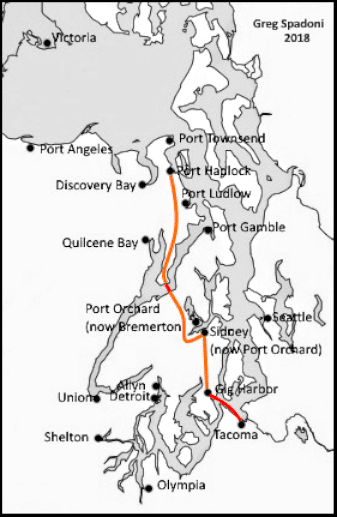
In 1893 the Northern Pacific RR surveyed a potential track line through Gig Harbor that terminated in Port Hadlock.
Frank Ross tries again
Ross was back in the news in 1897, announcing revisions to his previous plan for a railroad on the Olympic Peninsula. Once more his effort would stall, but again, he did not give up on the project.
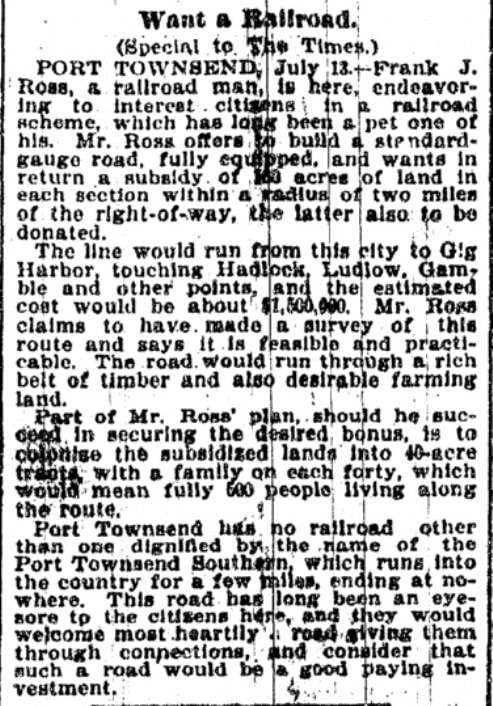
Gee, you don’t supposed the 1897 proposal of Frank Ross to build a railroad from Gig Harbor to Port Townsend was just a bit audacious, asking for fully 25% of all the land within a two-mile radius of the line be donated, free of charge, to his company?
He would not give up
Following the revised Frank Ross plan of 1897, the Gig Harbor railroad rumor mill was mostly silent until 1906, when stories of the Northern Pacific and Union Pacific being in competition for a freight railway to Port Townsend began to surface. The speculation was that the route might originate in either Olympia or Tacoma, and pass through Gig Harbor on the old Frank C. Ross route.
The rumors apparently had at least some substance, for in October of that year Ross walked the route over a two-week period with a civil engineer from an eastern railroad.
The Morning Olympian said the new line would leave Gig Harbor and pass through Purdy and Burley on the way to the head of Port Orchard Bay (present day Gorst). From there it was to go north to Dogfish Bay (Poulsbo) then continue north to about a mile south of the present-day Hood Canal Bridge, where it would cross the canal on barges. It would have branch lines to Bremerton and other communities along the way, and would include passenger cars from Gig Harbor to points north. Predictably, nothing ever came of any of it.
An actual railroad in Gig Harbor
Gig Harbor finally did get a railroad in 1909, but it was the very short road of the Gig Harbor Timber Company, used for transporting logs only. One of the owners claimed that before the logging railroad was built, he had been approached by men planning to build a line from Tacoma to Gig Harbor by railcar ferry, then to the Navy base in Bremerton. The men wanted the Gig Harbor Timber Co. to buy right-of-way through Crescent Valley instead of leasing it, he claimed. That would make the easements permanent and therefore available to the builders of the railway to Bremerton. In return, the railroad to the shipyard would haul the timber company’s logs for $1.25 per thousand board feet to its log dump in Gig Harbor.
A deal was never struck, the road to Bremerton was never built, and the loggers allowed the leases to expire after the trees were harvested.
A selling point
With the repeated resurfacing of rumors of a train line through Gig Harbor, mentions of the perpetually non-existent freight railroad sometimes found their way into local real estate advertisements as an extra incentive to buy land. A 1909 newspaper ad for berry farm tracts in Olalla included, “… this is on the main land, right on the proposed railroad between Gig Harbor and Bremerton. The survey running right through this property.”
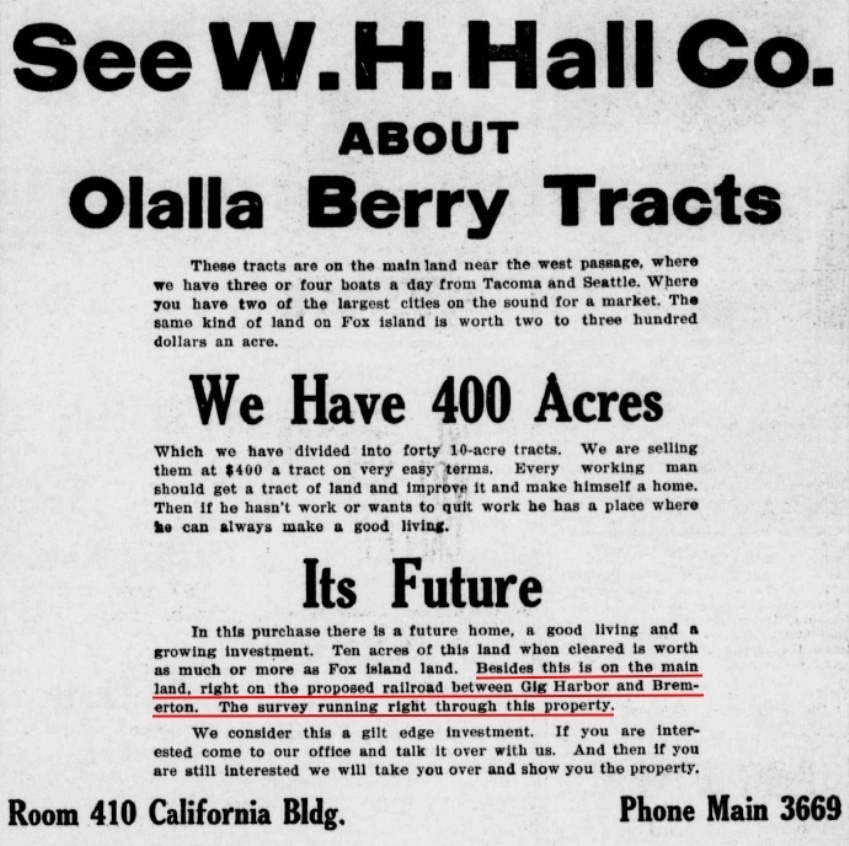
An advertisement in the Tacoma Times in 1909.
One last attempt
Frank Ross announced his final plan for the Tacoma & Northwestern railroad in 1911. He said he had secured right-of-way from Gig Harbor to Bremerton (formerly named Port Orchard) and would push the line from there to Port Gamble, where it would cross Hood Canal before continuing on rails. Instead of stopping at Port Townsend, this time the main line would run to Port Angeles. The terminus would actually be Victoria, British Columbia, on Vancouver Island. Like the Gig Harbor-Tacoma and Hood Canal crossings, train cars would be ferried between Port Angeles and Victoria on barges. Both Port Townsend and Port Orchard would be served by spur lines. Instead of steam, the locomotives would be gasoline powered, he revealed.
In spite of his 20 years of planning, the railroad was never built.
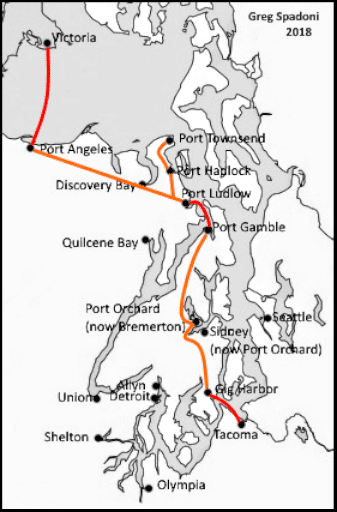
Frank Ross’ final plan for a railroad through Gig Harbor terminated in Victoria, B.C.
Although Frank Ross’ final plan for a railroad through Gig Harbor never went any farther than any of his previous ones, the rumor alone was reason enough for real estate advertisements to pick up on it again.

A real estate classified ad in The Tacoma Times in November, 1912.
An idea whose time had passed
After too many delays lasting too many years, the viability of a freight railroad through Gig Harbor evaporated with the dawn of the automobile age. Motor trucks became a more practical alternative. Roads for cars and trucks took all the attention away from roads for rails.
While Frank Ross envisioned a railroad passing through Gig Harbor, it probably never crossed his mind that an automobile road would eventually pass right through his Gig Harbor house. But it did, and still does. It’s one of the busiest streets in Gig Harbor. And wouldn’t you know it, we’ve run out of space in this week’s column to tell you where it is.
Dang those self-imposed word count limits!
We have room only for a preview of our next topic.
Next time
Our April 21 column will be an either-or choice. Depending on how quickly or slowly I’m able to dig up certain information for completing my second entry in the Behind the Finds series, it could be that story or will be something already in the can.
If not my second entry in Behind the Finds, the April 21 column will mark the debut of a new category of Gig Harbor Now and Then columns, titled Notable Scoundrels of the Peninsula. While the title is new, the concept is not, for the first real entry was Huckleberry Bolton, in the December 16, 2024, column. That was before the obvious category name had been thought up.
The history of every small community has its share of less-than-stellar personalities, which is a fairly benign way of saying thieves, scoundrels, bigamists, embezzlers, child abusers, conmen, habitual liars, and sometimes even a murderer or two. Most of the unsavory characters are usually forgotten after a generation or so, and the few that are not are often miraculously converted by researchers of history into upstanding, courageous, pillar-of-the-community types, simply because only their good deeds have been remembered. Notable Scoundrels of the Peninsula will uncover some of the worst deeds of some of the worst people. Doesn’t that sound like fun?
— Greg Spadoni, April 7, 2025
Greg Spadoni of Olalla has had more access to local history than most life-long residents. During 25 years in road construction working for the Spadoni Brothers, his first cousins, twice removed, he traveled to every corner of the Gig Harbor and Key Peninsulas, taking note of many abandoned buildings, overgrown farms, and roads that no longer had a destination. Through his current association with the Harbor History Museum in Gig Harbor as the unofficial Chief (and only) Assistant to Linda McCowen, the Museum’s primary photo archive volunteer, he regularly studies the area’s largest collection of visual history. Combined with the print history available at the Museum and online, he has uncovered countless stories of long-forgotten local people and events.


